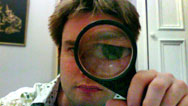The Dark Matter Mystery
- By Melissa Salpietra
- Posted 06.01.08
- NOVA scienceNOW
We can't see dark matter, and some skeptics doubt its existence, but many scientists think it makes up more than 20 percent of our universe. Astronomer Doug Clowe explains how the Bullet Cluster, a group of galaxies billions of light-years away, may shed some light on this mysterious stuff.
Transcript
Dark Matter Mystery
Posted: June 1, 2008
NEIL DEGRASSE TYSON: My galaxies are purple, how about yours?
DOUG CLOWE: Mine are sky blue
NARRATOR: Here at NOVA we do a lot of things in the name of science.
NEIL DEGRASSE TYSON: Are you ready? One...two...three!
NARRATOR: Just ask NOVA scienceNOW host Neil deGrasse Tyson. And not all of it is done purely for fun. Like astronomer Doug Clowe, sometimes we're trying to explore the deepest mysteries of the universe. And dark matter is definitely one of these mysteries.
DOUG CLOWE (Ohio University): When astronomers refer to dark matter we mean something that doesn't interact with light in any way. It doesn't give off light. It doesn't absorb light.
NARRATOR: Scientists like Clowe think dark matter may make up about 20-some percent of our universe, but there's something else they aren't so sure about.
DOUG CLOWE: We don't know what dark matter is. We think it's probably some sort of particle that we haven't discovered yet, but it might turn out to be something different. We're not entirely sure.
NARRATOR: So why is Clowe convinced that it actually exists? Say hello to the Bullet Cluster. These two immense groups of galaxies billions of light years away offer some clues in the dark matter mystery.
DOUG CLOWE: So the bullet cluster is actually made up of two separate clusters of galaxies. About 100 million years ago, gravity pulled them together and smashed them into each other. So, in this collision, we have these two types of matter. We have the galaxies and we have the 100 million degree gas which sits between all the galaxies. 100 million degree gas, yeah.
NARRATOR: So what, you might be asking, do the galaxies and gas of the bullet cluster have to do with dark matter? Lets create a mini bullet cluster collision to demonstrate. And here to help is Neil deGrasse Tyson.
DOUG CLOWE: So when we take these two separate clusters of galaxies in the bullet cluster and smash them together, the galaxies continue straight on with out really any effect. The gas clouds however are going to behave just like any other sort of gas, so they actually do collide. This is going to slow them down. And so now when we look to this cluster about 100 million years later the galaxies are moving faster than the gas clouds, and so they're going to be further away from the center of this collision.
NARRATOR: In the center of this collision are the intergalactic gas clouds, lagging behind the faster moving galaxy clusters.
DOUG CLOWE: The galaxies are now in a physically separate part of the sky from what the gas is. And so we've separated out the two types of matter which we can see.
NARRATOR: Now here is the important part--matter creates gravity. More matter, more gravity.
DOUG CLOWE: 90% of this matter is in the gas cloud, so that is where the gravity should be.
NARRATOR: But when all data was put together, that was not the case.
DOUG CLOWE: Instead we see that most of the gravity is around the galaxies, and that tells us that something else has to be there causing this gravity. It can't just be the stars and the galaxies themselves.
NARRATOR: So is this evidence for dark matter? Let's ask three top experts in the field...
PETER FISHER: There is clearly some stuff there that is not normal matter and that's making a lot of gravity.
RICHARD MASSEY: I really believe that there really, there is some dark matter there.
MAX TEGMARK: So I think the bullet cluster really is the silver bullet that kills off a lot of theories trying to explain away dark matter.
NARRATOR: Although the dark matter mystery isn't completely resolved, we may have good reason to be grateful for this mysterious stuff.
DOUG CLOWE: Dark matter is basically the glue that holds all the large structures in the universe together. So without dark matter, we would not currently be here.
NARRATOR: So three cheers for dark matter....whatever it may be.
Credits
Production Credits
- Video podcast produced by
- Melissa Salpietra and Susan K. Lewis
- Edited and narrated by
- Melissa Salpietra
- Original footage and interviews produced for NOVA by
- Julia Cort
Related Links
-

Dark Matter
Physicists have a sneaking suspicion that most of the universe is held together by a mysterious, invisible substance.
-

Dark Matter: Expert Q&A
Astronomer Richard Massey answers questions about dark matter and other otherworldly enigmas.
-

Picturing Atoms
Hear why orbiting electrons drive NOVA scienceNOW host Neil deGrasse Tyson batty.
-

In Pursuit of Dark Matter
We're about 12 million cosmic ray collisions from better understanding dark matter, say physicists at CERN.



